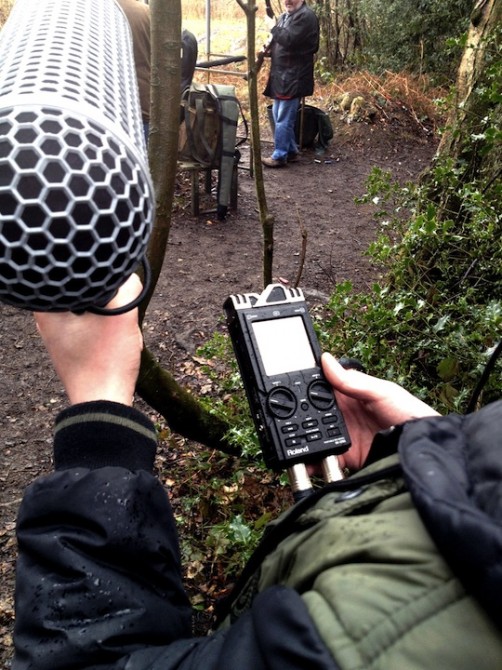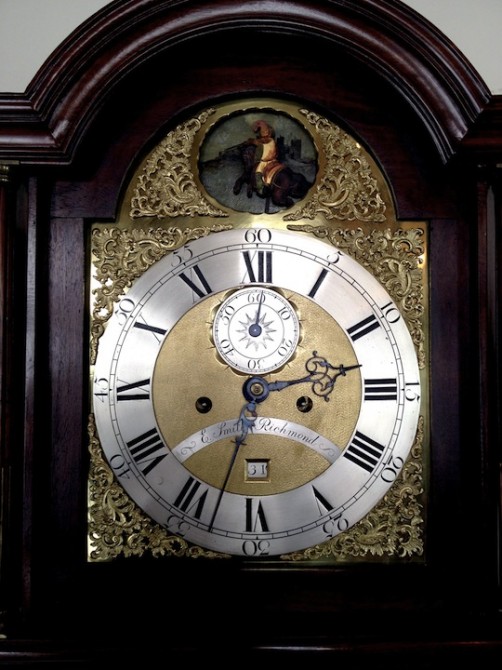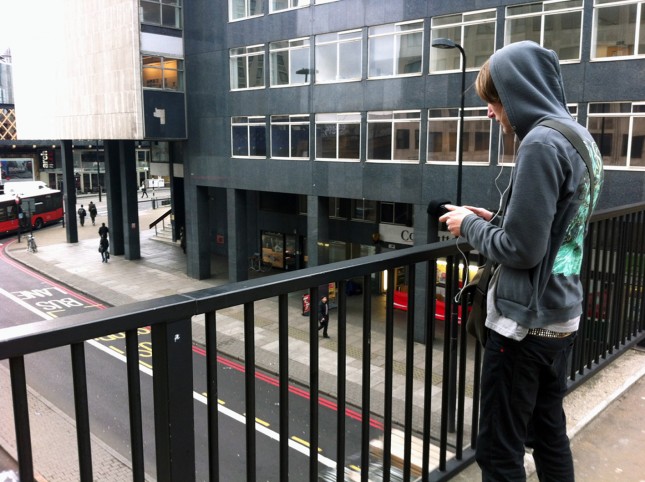Guest contribution by Chris Didlick
We are Box of Toys Audio, a music and sound design company with studios in London and Stockholm. We provide audio services for commercials, branding, trailers and all manner of projects. With the ongoing innovation and expansion of digital media we are sometimes offered new and uncharted avenues for creativity, which is why when we were asked to work on the new Madefire Motion Book platform we embraced the challenge readily.
Madefire is an iOS app that has been optimised for the iPad and iPhone, emulating the traditional graphic novel format with the addition of motion, interactivity and audio. What’s more, Madefire is also releasing, in phases, free development tools that can be used by independent artists to create and publish their own stories on the platform. With Moving Brands CEO Ben Wolstenholme and comic book legends Dave Gibbons and Liam Sharp involved in the creation of the app, we jumped at the chance to create the audio for the first three in-house story releases, namely “Treatment”, “Captain Stone is Missing…” and “Mono”. Not only were we creating the audio for the narratives, we were also constructing an SFX library for use within the development tool. It was therefore important that the audio enhanced each story while being effective for future titles.
A large part of the Madefire audio suite consisted of ambient beds. These would serve as a backdrop to each scene and aim to further immerse the reader in the story. We recognised early on it was important to enhance the reading experience rather than detract from it. We wanted to instill mood and atmosphere without interfering with the flow of events. One thing that helped us to achieve this was to ensure that the ambiences were dynamically flat and did not involve large spikes of distracting events.
In the early stages, each story was already scripted out but the art and text were still in production. This was an enjoyable challenge as we found ourselves ‘auralising’ each scene with reference to the written script, as opposed to a visual reference. What we had created was an audio storyboard that helped us allocate our requirements across several recording sessions and plan ahead accordingly.
 An initial concern was that guns and battlefields featured quite heavily throughout the stories, yet a full blown firearm recording session was not within our remit. After some scouting around, the Madefire guns and WWII battlefield ambience came courtesy of Surrey Sporting Club who kindly let us record them for a day with our Sennheiser MKH 416 mics and a Roland R-26 recorder. With this set up we were easily mobile and could make use of independent XLR gain to adapt to different mic positions on the fly. The daylong session involved shadowing members who cycled through a series of shooting positions at the edge of a wood, pointing towards a central common. Due to the nature of the schedule guns were firing at all times at various distances, which allowed us to not only target near field shooters but also capture gunfire from the far field. Not all club members were aware of our intentions however, and assumed we were monitoring decibel levels for the local council! After a few hasty explanations, and manly handshakes, we were glad to hear back at the studio that we had captured not only the initial attack of the guns but also a lovely downrange peel out. The true character of the gunfire only revealed itself after a certain amount of compression and we were able to isolate, design and process the close range guns for ‘first person’ weapons and edit up the distant gunfire for what was predominantly used as the WWII ambience in “Mono.”
An initial concern was that guns and battlefields featured quite heavily throughout the stories, yet a full blown firearm recording session was not within our remit. After some scouting around, the Madefire guns and WWII battlefield ambience came courtesy of Surrey Sporting Club who kindly let us record them for a day with our Sennheiser MKH 416 mics and a Roland R-26 recorder. With this set up we were easily mobile and could make use of independent XLR gain to adapt to different mic positions on the fly. The daylong session involved shadowing members who cycled through a series of shooting positions at the edge of a wood, pointing towards a central common. Due to the nature of the schedule guns were firing at all times at various distances, which allowed us to not only target near field shooters but also capture gunfire from the far field. Not all club members were aware of our intentions however, and assumed we were monitoring decibel levels for the local council! After a few hasty explanations, and manly handshakes, we were glad to hear back at the studio that we had captured not only the initial attack of the guns but also a lovely downrange peel out. The true character of the gunfire only revealed itself after a certain amount of compression and we were able to isolate, design and process the close range guns for ‘first person’ weapons and edit up the distant gunfire for what was predominantly used as the WWII ambience in “Mono.”
Click here to listen to the “Battlefield” Ambience. [Again, apologies for the click through. SoundCloud embeds still aren’t working.]
 “Mono” portrays a fair amount of solitude and nostalgia in the opening scenes of Edward Heston’s house, with a grandfather clock as the perfect symbolic representation of time past. Pendulum of Mayfair, a London based antique clock dealer, very kindly took time out of their day to let us into their showrooms and record some of the grandfather clocks on display. The accommodating owners gave us permission to get in and around the clocks to capture the character of each model. We were too busy being careful to find out more about what we were recording but they were definitely very old and sounded great. Each clock had its own brand of ‘tick’, so we were able to choose from quite a broad range of sounds to achieve the mood we were looking for.
“Mono” portrays a fair amount of solitude and nostalgia in the opening scenes of Edward Heston’s house, with a grandfather clock as the perfect symbolic representation of time past. Pendulum of Mayfair, a London based antique clock dealer, very kindly took time out of their day to let us into their showrooms and record some of the grandfather clocks on display. The accommodating owners gave us permission to get in and around the clocks to capture the character of each model. We were too busy being careful to find out more about what we were recording but they were definitely very old and sounded great. Each clock had its own brand of ‘tick’, so we were able to choose from quite a broad range of sounds to achieve the mood we were looking for.
Listen to the clock in the hallway. [SoundCloud]
One of the scenes in the Treatment series of stories was a Day Of The Dead carnival. Listening back through previous recordings on our Zoom H2 we found a recording of a food market during a trip to the 2011 Barcelona OFFF festival. Despite not really having any real purpose for the recording, the general walla was aptly blurred yet featured the correct lingual tone for a Mexican setting. When combined with various percussion recorded in the studio and a busker’s steel guitar from the same Barcelona trip, the ambience needed for this scene came to life. This exercise really inspired us to stay proactive with recording, to the point where the Tascam IM2 iPhone mic became a permanent fixture to our utility belts.
Mexican Day of the Dead Festival. [SoundCloud]
A similar example is the graveyard ambience within “Treatment: Mexico City.” The church bells were recorded at Ilfracombe, Devon and required a fair amount of seagull removal, but appeared to be perfect for the job. The crows were captured outside our studio window. These recordings were combined with the pitched up jangling of keys against our speaker stands, for an effective flag pole tapping sound that could easily be associated with desolate and isolated buildings. To glue these elements together we needed a more consistent base of exterior ambience, so we used recordings of grasshoppers and crickets alongside wind synthesised with NI Reaktor. The wind was a product of 4 or 5 noise generators that were filtered to different bands and given individual movement with an LFO module. A certain amount of randomisation was then added to higher frequency elements to give more of a natural flutter.
Graveyard Ambience. [SoundCloud]
Another “Treatment” themed ambience (one of our personal favourites) is the Future City, which we used in “Treatment: Tokyo.” This was very much inspired by the cityscapes of Blade Runner and Fifth Element, an influence that is hopefully evident to the listener. Our sound design assistants, the dynamic duo Dan and Dougie, had done a great job of capturing the sounds of central London. One recording in particular really conveyed the ambience of the city without featuring too much in the way of close traffic or recognisable sounds. This, alongside the rumble of a passing train, served as the foundation that we built on. The majority of the traffic flybys were created using noise generators and heavily LFO’d sine/saw waves from the Roland SH-101 and Lennar Digital’s Synlenth, which were then treated with a doppler effect. With our influences in mind, we also created a foghorn by heavily processing a tuba sample, sirens from modulated sine waves and an unintelligible female announcement by EQ’ing, pitching and applying reverb to a recording of Dougie’s voice. We don’t know any girls ;)
The future city. [SoundCloud]
We also wanted to create a series of more abstract ambiences. These were intended to assist the more bizarre scenes of “Captain Stone”, but given the non-literal nature of these sounds, we anticipated that they would be of particular use within the development tool SFX library. Contemporary comic books being what they are, these abstract ambiences were mostly dark in nature and were created once again using NI Reaktor – or more specifically using the ‘Metaphysical Function’ ensemble. By using the randomisation function and a bit of tweaking to further develop the sounds, we found we could create no end of ambient layers, which could be combined, reversed and looped for a series of more non-diagetic soundscapes. This ensemble was particularly appropriate as it combines synthesised and sampled elements to create a more natural timbre overall.
Dream Drone. [SoundCloud]
Implementation of the audio was carried out using Madefire’s Motion Book development tool. The software itself was hosted via an online portal so we were able to populate projects in real-time and allow the Madefire team in San Francisco to review our progress as it happened (allowing 8 hours latency!). With the project aimed at portable devices, MP3 was the primary format used, so latency and upload issues were not a problem. The entire approach of the tool is timeline based in a non-traditional sense, in that it focuses on a series of marked events for images, text and audio. The events are triggered by the reader as they tap their way through the story, so we were able to fade in or fade out audio elements according to the reader’s progress. The only other available parameters (currently) are volume and loopcount, and so any reverb, EQ etc. had to be baked in. This resulted in some trial and error but considering the audio had been created ‘blind’ the majority of it fitted surprisingly well. We aimed for a target of about 30 seconds per ambience as this seemed a good balance between variation and precious storage space.
This was one of our most engaging projects to date and overall, I we think taught ourselves a lot about organisation and resourcefulness. I hope that by writing this we can pass some of that on and inspire others to find creative solutions in any scale of the project. To echo Chris Groegler’s previous article, with a little care and creativity it is possible to get great results whatever your means.
This guest post was contributed by Chris Didlick of Box of Toys. Remember that next month’s featured theme is reverb…and if you have an idea for an article you’d like to share with the rest of the community, then we want to hear from you. Contact shaun.at.designingsound.org for information.
